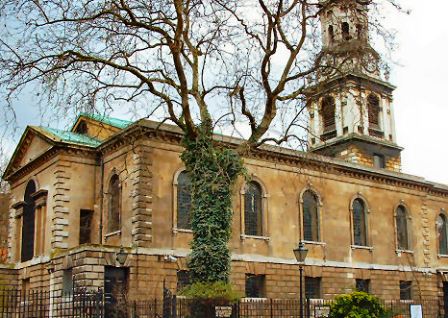One of the churches to be beautified in London in the 1620 and 1630’s through the encouragement of William Laud was St Giles-in-the fields. Lady Alice bore most of its cost.
She was a granddaughter of the Earl of Leicster (Robert Duddley) but did not follow in his footsteps. At an early age she was living piously, that only increased as she became older. Preaching at her funeral on the 14th March, 1669, the vicar of the above church, Robert Boreman, he informed those present: "Her behaviour towards God was rare and admirable; for being instructed in, and persuaded of the truth of that Religion which we profess ...and being firmly grounded in those Fundamentals, and saving Truths which our Religion teaches us... she served God `night and day (as Anna did) ...with fastings and prayers', especially during her time of her Virgin-widowhood.”
One of her outstanding virtues was her patience, manifested so well during the Interregnum. Boreman explained it like this:
"But she with a most heroic Christian-like courage and spirit, bore up against all the batteries and storms of plundering persecutors, of railing `Shimei's', and backbiting `Rabsshakes', against who her innocency was no fence to keep of their approaches: And as those lesser lights of Heaven shine brightest in the dark Winter nights, and fire burns hottest in the cold frost, so the Star of her profession shine most gloriously, the fire of her zeal to the Truth glowed with a greater heat under the rage of those, who did persecute her with their hands robbng her of her goods (because she would not be as they were, bad, rebels against the King and Church) and blasting her reputation with their black tongues not dreading to report she was a Papist, ..or something like one: and why? Because she was loyal to her sovereign, a lover and Patroness of Orthodox Divines, and abounding in good works.....the practice of the true religion manifested to the World that she was a rare Christian, A Christian indeed and not only in name.”
She was indeed a faithful daughter of the English Church and her charity was almost bottomless illustrated in her generous gifts to repair churches, install altar rails, church plate and cloth and vestments. Amongst those churches and cathedrals that benefit from her charity was St. Giles-in-the field, Lichfield cathedral, the parish church of Stonely (she is buried here), Leke-Wotton, Ashow, Kenelworth and Monkskirby in Warwickshire, and St. Sepulchres in London.
How beautiful these churches were adorned is seen in St. Giles’. The screen was placed in its old position, and hence the Sanctum Sanctorum, was once more separated from the rest of the church. This large wooden screen was styled in “the figure of a beautifull gate” on which were “carved two large pillars and three large statues”: Paul with his sword, Barnabas with his book, and above them was “Peter with his keys”. Towering over these were “winged cherubims” supported by lions. The altar at the east end, approached by three steps, was railed off, and behind it hung “blue silke taffeta curtaines.” The altar was covered on weekdays with “a Rich Green Velvet Cloth” with the sacred monogram IHS embroidered in gold, whilst for Sundays there was an even more elaborate green velvet frontal with its “rich deep Gold fring”. There were also two altar cloths, one of cambric with deep bonelace around its edges, and the other of damask, while on weekdays a large Turkey carpet covered the altar. Furthermore there were two richly and golden embroidered cushions on which to place the service books or alms basin on the altar. Within the carpeted sanctuary there was also a desk covered in purple velvet with “a great gold and silke fringe” on which were “placed two great bookes, wrought with needle-worke in which were made the pictures of Christ, and the Virgin Mary with Christ in her armes.”
All this beautification to the glory of God did not mean anything to the iconoclasts of the 1640’s, and like so many churches and college chapels, it suffered unmercifully. Nevertheless at the Restoration, as Boreman intimated in his funeral oration for Lady Alice in 1669, St. Giles was “rebeautified, though not in the same high degree and manner as before”.
Lady Alice’s charity embraced the poor too of St. Giles and other parishes not only during her life but in provision after her death.
In her sickness she spent her time “in heavenly conversation”, prayer and repentance and for her journey into the next she deeply desired to received Viaticum. Even in her weakened state when she could hardly moved she knelt to receive “that heavenly Food which Physicks the Soul for Eternity, the seal of her pardon, and token of her Communion with Christ.” In delivering the funeral oration Boreman praised her for “her devout deportment,” and for her divine praises. Indeed to be in her presence one was conscious of being in the presence of “a rare saint”.
LADY DUDDLEY (1579 - 1669)

